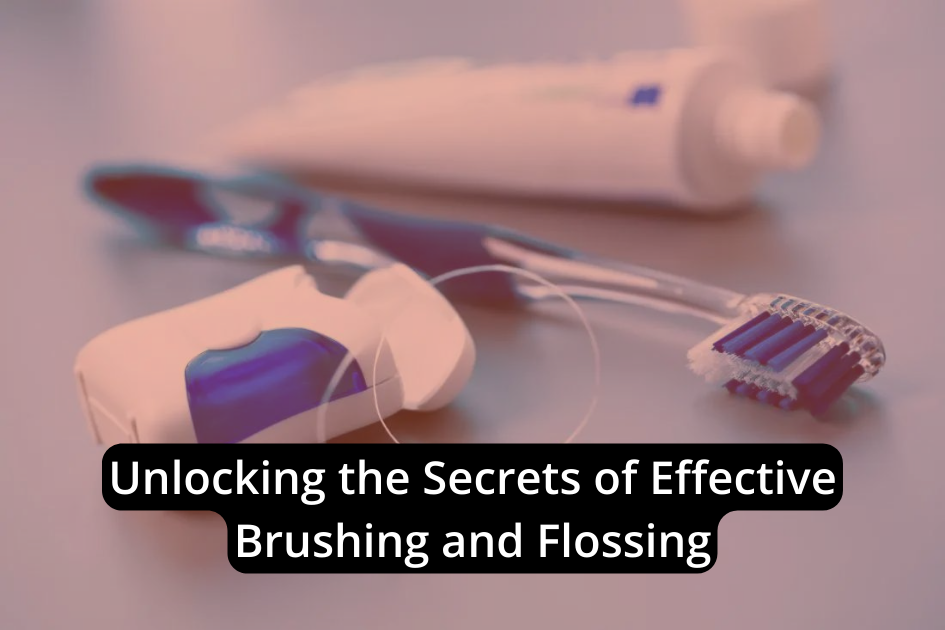Are you aware that nearly 30% of adults fail to brush their teeth twice daily? This statistic might not shock you as much as it should. It seems brushing and flossing effectively is more intricate than most individuals comprehend, leading to the easy adoption of bad habits.
Understanding the Basics of Oral Hygiene
Understanding the essentials of oral hygiene requires knowledge that consistent and proper brushing and flossing are critical in warding off tooth decay, cavities, and gum disease. The importance of effectively removing plaque, a sticky accumulation of sugar, protein, and mucous can’t be overstated. This unpleasant substance adheres to your teeth and gums, causing health complications if not eliminated.
Flossing is integral to removing plaque concealed between teeth, where your toothbrush doesn’t reach. For successful flossing, encircle the floss around each tooth, moving it vertically. During brushing, adopt a 45-degree angle to oscillate between teeth and gums. Following these recommendations, we’re progressing towards healthier teeth and gums.
Importance of Regular Brushing
Understanding the significance of routine tooth brushing is a stepping stone to reaching peak oral health. It assists in eradicating plaque, the primary cause of tooth decay and gum disease. Effective plaque removal can help ward off tooth decay and sustain a healthy smile.
Here are three crucial reasons why brushing regularly is essential:
- Consistent brushing eradicates the sticky bacterial film called plaque. If not managed, plaque may lead to tooth decay and gum diseases.
- Cleaning your teeth twice a day aids in the removal of food remnants and bacteria that result in unpleasant breath and teeth discoloration.
- A routine of brushing leads to healthier gums, and robust teeth, and contributes to our overall health.
Steps for Effective Tooth Brushing
Our discussion will encompass topics such as selecting an appropriate toothbrush, mastering the correct brushing method, comprehending the significance of fluoride toothpaste, and figuring out the best brushing frequency and timing.
These recommendations will ensure we’re brushing effectively for the best oral health, rather than just going through the motions.
Choosing Your Toothbrush
Choosing the appropriate toothbrush is an essential step toward effective teeth cleaning. The toothbrush selection significantly influences your oral and dental health as it impacts the cleanliness of your teeth and gums.
- 1. Opt for a toothbrush featuring soft, rounded bristles. Such a toothbrush safeguards your gums from potential harm while ensuring efficient cleaning.
- 2. A toothbrush with a small head is a good choice. It enables access to difficult-to-reach areas, guaranteeing comprehensive cleaning.
- 3. Ensure your toothbrush has the ADA seal of approval. This certification confirms that your toothbrush meets the required standards for quality and effectiveness in removing plaque.
Proper Brushing Technique
Once the appropriate toothbrush has been chosen, mastering the correct brushing method becomes a crucial aspect of maintaining optimal dental hygiene. Our brushing method begins by placing the toothbrush at a 45-degree angle against the gum line. This position enables the bristles to cleanse beneath the gum line, helping to eliminate food particles and plaque.
The mouth should be divided into sections, with gentle, back-and-forth strokes applied to each for approximately 30 seconds. It’s vital to change the toothbrush every three months to ensure effective oral care at home.
Importance of Fluoride Toothpaste
Consistent usage of fluoride toothpaste is essential as it fortifies our tooth enamel and obstructs decay by remineralizing our teeth. This potent component in our toothpaste receives global recognition from dental societies for its efficiency in preserving our oral health.
Here are three principal advantages of fluoride toothpaste:
- Fluoride toothpaste contributes to the avoidance of cavities by creating a defensive shield against acid onslaughts from bacteria residing in our mouths.
- This toothpaste can reverse preliminary indications of tooth decay, thus halting further harm.
- Regular application of fluoride toothpaste, as suggested by dental experts, guarantees the best possible oral health.
Essentially, fluoride toothpaste is a vital participant in our battle against tooth decay and cavities, and a fundamental element in preserving our oral health.
Brushing Frequency and Timing
For optimal oral health, it’s imperative to brush our teeth at least twice a day, preferably after meals, to get rid of food particles and prevent bacterial growth. Regular brushing and flossing is an essential part of maintaining good oral hygiene.
Each brushing session should last for at least two minutes to ensure every surface of each tooth is properly cleaned. Break down your mouth into sections and spend approximately 30 seconds on each for a comprehensive clean.
Utilize a soft-bristled toothbrush and fluoride toothpaste as they’re the most effective in plaque elimination and cavity prevention. It’s essential to understand that proper brushing and flossing isn’t solely about frequency but also involves mastering the technique.
Significance of Dental Flossing
Without question, dental flossing holds a crucial role in preserving prime oral health by scrupulously eliminating plaque and food remnants from those difficult-to-access areas between our teeth where brushing alone fails to cleanse. Flossing holds as much significance as brushing for oral hygiene, aiding in halting gum disease by reducing bacteria and inflammation in hard-to-reach areas.
Let’s examine the details:
- Flossing enhances brushing by ensuring a comprehensive clean and accessing places a toothbrush misses.
- It assists in diminishing the risk of unpleasant breath, gum disease, and cavities by eradicating the bacterial plaque that builds up between teeth.
- Consistent flossing not only boosts gum health but also considerably reduces the risk of periodontal diseases.
- Encircle each tooth with the floss, moving it vertically to displace plaque.
- Bend the floss around the tooth and glide it beneath the gum line to ensure effective cleaning.
- Incorporate flossing into your daily routine to lessen the likelihood of gum recession and inflammation over time.
- Mouthwash – It does more than just give fresh breath. Regular use of mouthwash along with brushing and flossing can drastically decrease plaque and gingivitis.
- Water Flossers – They’re an excellent alternative for those who find traditional floss challenging. These are efficient in getting rid of food particles and plaque lodged between teeth.
- Tongue Scrapers – These devices help eliminate bacteria and debris from the tongue, which in turn results in fresher breath.
- Interdental Brushes – They can access areas that floss mightn’t reach, thus making them a valuable tool in your oral hygiene routine.
- Fluoride Treatments – These treatments, when used properly, can fortify tooth enamel and prevent decay.
- Vigorous brushing in a back-and-forth motion can exert excessive force, leading to enamel degradation.
- The importance of flossing is often overlooked, despite its crucial role in eliminating odor-inducing bacteria and food debris lodged between teeth.
- Regular, gentle brushing of the tongue is frequently ignored, even though it’s a breeding ground for bacteria that can trigger serious health complications if left unchecked.
Proper Flossing Techniques
We’ll explore selecting the appropriate floss for your oral hygiene needs, mastering the motions for efficient flossing, and avoiding gum injury while ensuring comprehensive cleanliness.
It’s not merely about slipping floss between your teeth; there’s a technique to it that we’ll explain to you.
Choosing the Right Floss
Maintaining optimal oral health requires the right choice of floss and the use of proper flossing techniques. Given the variety of floss types on the market, it’s crucial to pick one that caters to your specific requirements.
Waxed floss is widely favored because it easily slides between teeth. Its special coating makes flossing a more comfortable task, particularly if your teeth have little space in between.
On the other hand, unwaxed floss, despite being thinner, can prove just as effective. It’s especially beneficial for closely placed teeth.
For individuals with braces or dental implants, floss threaders can simplify flossing. They enable effective maneuvering around your dental fixtures.
Certain flosses are available in assorted flavors such as mint or cinnamon, enhancing the overall flossing experience. Ultimately, it’s about discovering what suits you optimally.
Mastering Flossing Movements
Mastering the skill of flossing involves understanding and practicing proper techniques. This includes using approximately 18 inches of floss secured around your fingers for optimal reach, cleaning the spaces adjacent to the gums, and shaping the floss around each tooth to effectively remove plaque and debris.
Regular and correct flossing can reduce gum bleeding over time and enhance gum health. It’s also crucial to remember to floss your back teeth, which are often overlooked. The method of brushing and flossing should be practiced daily to maintain excellent oral health.
For those who find conventional flossing challenging, pre-threaded floss holders might be a beneficial alternative. Persistent practice is key to achieving a healthy smile.
Preventing Gum Damage
Maintaining optimal oral health necessitates the implementation of correct flossing techniques. These techniques not only facilitate the extraction of plaque and bacteria between teeth but also assist in averting gum damage. We shouldn’t depend entirely on our toothbrush to access the hidden recesses where plaque accumulates.
To guarantee healthier gums and avert gum damage, consider these three crucial procedures:
Choosing the Right Floss
Selecting the appropriate floss requires a careful evaluation of the variety of options available, taking into account personal preferences and dental conditions. A wide range of floss types exist, including waxed, unwaxed, tape, and flavored varieties. Each type is specifically designed to accommodate different dental states and tastes.
Some are designed for conditions such as tight spaces, braces, or sensitive gums. The floss material, be it nylon, silk, or PTFE (polytetrafluoroethylene), provides a variety of textures and strengths for effective cleaning. For those who struggle with traditional flossing, alternatives such as water flossers or oral irrigators can be a worthwhile solution.
Floss threaders or interdental brushes are also useful in cleaning difficult-to-reach areas between teeth or around dental appliances.
Role of Other Dental Products
Apart from brushing and flossing, other dental products significantly contribute to oral health. Here, we’ll discuss the advantages of some of these items:
Maintaining a Brushing and Flossing Routine
Establishing and maintaining an effective brushing and flossing routine is simpler than it appears. Ensuring optimal oral health requires regular plaque removal and prevention of gum disease. This can be achieved by brushing our teeth a minimum of two times a day and combining this with daily flossing.
Each brushing session should last two minutes, using a 45-degree angle to reach between teeth and gums. Flossing is just as vital, as it cleans areas a toothbrush can’t reach. Consistency plays a significant role in upholding this routine, contributing to a reduction in cavities, bad breath, and other oral hygiene problems.
It’s worth noting that our oral health mirrors our overall health. Hence, it should be given top priority.
Addressing Common Oral Health Mistakes
Many individuals, without realizing it, commit errors in their oral hygiene regimen that can inflict enduring damage on their teeth and gums. Here are three such common blunders:
Conclusion
We can’t emphasize enough the significance of correct tooth brushing and flossing. It’s not merely about maintaining a radiant smile but also preserving overall dental health. With optimal techniques and the right products, you can fight against plaque accumulation and decrease the possibility of gum disease.
Consistency plays a crucial role. Incorporate these habits into your everyday routine. With a bit of conscientiousness, you’ll witness substantial progress. We at Family Dental of Teravista in Georgetown, TX are sure that you can obtain and uphold a healthy, attractive smile.
So, why wait? Start taking steps today towards better oral health and see the difference for yourself.














